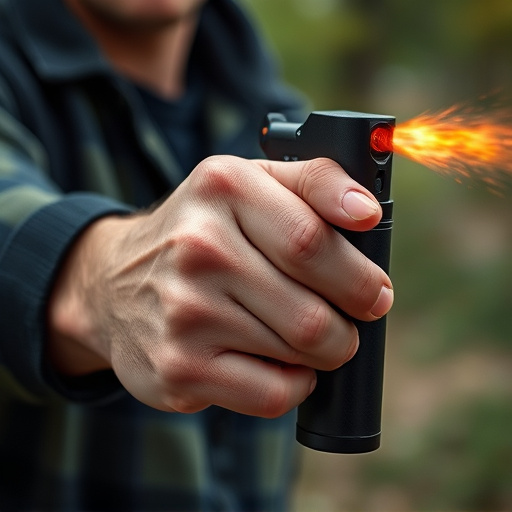Low light pepper spray tactics have emerged as a game-changer in personal safety, offering non-lethal means to deter and protect individuals in dimly lit or dark environments. These specialized tools, equipped with advanced illumination systems, enable accurate deployment even without clear visibility. With proper training, users can enhance their personal safety awareness and effectively deter threats, minimizing harm while creating de-escalation time for backup. Legality and responsible ownership vary by location; understanding local laws, securing storage, and ensuring safe use through training are crucial to avoid legal issues.
“Unveiling a revolutionary non-lethal inflammatory self-defense tool, this article explores a new paradigm in personal safety. We delve into the intricacies of low light pepper spray, its unique features, and unparalleled benefits for individuals seeking to protect themselves in various situations.
From understanding the science behind its effectiveness to tactical applications, we explore real-world scenarios where low light pepper spray can be a game-changer. Furthermore, we provide insights into legal considerations and responsible ownership practices, ensuring readers are equipped with knowledge beyond just acquiring this powerful defense mechanism.”
- Understanding Non-Lethal Inflammatory Tools: A New Paradigm in Self-Defense
- Low Light Pepper Spray: Features and Benefits for Personal Safety
- Tactical Application: Effective Use Scenarios and Techniques
- Legal Considerations and Responsible Ownership of Non-Lethal Self-Defense Devices
Understanding Non-Lethal Inflammatory Tools: A New Paradigm in Self-Defense
In recent years, the concept of non-lethal inflammatory self-defense tools has emerged as a game-changer in personal safety. These innovative devices offer a new paradigm in self-defense, providing individuals with effective means to deter and protect themselves without causing permanent harm or fatal consequences. Unlike traditional lethal options, non-lethal tools focus on incapacitating an aggressor temporarily through various methods, including low light pepper spray tactics. This shift towards less harmful alternatives is not only a step towards responsible self-defense but also addresses concerns about the overuse of lethal force in certain situations.
Low light pepper spray, for instance, is designed to disrupt an attacker’s vision and respiratory system, enabling the user to create a safe escape or summon help. The strategic use of such tools in low-light conditions, like during nighttime encounters, can prove invaluable. With proper training, individuals can master low light pepper spray tactics, ensuring they have a reliable self-defense mechanism readily available when needed. This new era of self-defense empowers folks to take control and protect themselves while navigating the complexities of modern urban environments.
Low Light Pepper Spray: Features and Benefits for Personal Safety
Low light pepper spray is a non-lethal self-defense tool designed for use in dimly lit or total darkness environments, providing users with an effective means to deter and disable attackers without causing permanent harm. Unlike traditional pepper spray that relies on clear visibility, low light varieties are equipped with specialized components that enable them to deploy irritants even when vision is impaired. This makes it a valuable addition to any personal safety arsenal, especially for individuals who frequently find themselves in low-light scenarios such as night shifts, outdoor enthusiasts, or those living in areas prone to power outages.
The features and tactics associated with low light pepper spray include advanced illumination systems like UV or infrared lights that can penetrate darkness, allowing users to aim and deploy the spray accurately. These tools often come with compact designs, easy-to-activate mechanisms, and robust construction to withstand tough conditions. The benefits are clear: increased safety, improved awareness, and a powerful deterrent against potential threats. With proper training in low light pepper spray tactics, individuals can gain confidence in their ability to protect themselves effectively in challenging situations.
Tactical Application: Effective Use Scenarios and Techniques
In low light scenarios, such as nighttime operations or enclosed spaces with dim lighting, tactical professionals can leverage low light pepper spray tactics for effective self-defense. This non-lethal inflammatory tool is designed to disrupt and disorient potential threats while ensuring minimal harm to bystanders. Officers or individuals trained in its use can employ precise techniques, like aiming for the face and eyes, to neutralize an aggressor’s ability to fight back without causing permanent injury.
The strategic application of low light pepper spray involves quick deployment and calculated movement. Users should practice proper breathing techniques to avoid inhaling the spray themselves and aim for areas like the nose, mouth, and eyes, where sensitivity is highest. This approach allows for a swift de-escalation of high-stress situations, providing critical moments for additional backup or de-escalation tactics to take effect.
Legal Considerations and Responsible Ownership of Non-Lethal Self-Defense Devices
The legality and responsible ownership of non-lethal self-defense devices, including low light pepper spray tactics, vary significantly across jurisdictions. It’s crucial for individuals considering such tools to understand local laws and regulations governing their use. While many regions allow the possession of non-lethal sprays for personal protection, restrictions on capacity, type of chemical, and permissible circumstances exist. Owning and carrying these devices responsibly involves adhering to legal guidelines, storing them securely, and ensuring proper training in their safe and effective deployment.
Responsible ownership also includes being aware of potential risks and ethical considerations. Users must be educated about the effects of pepper spray, including its impact on individuals with medical conditions or disabilities. Additionally, understanding the chain of custody and documentation requirements for any use of such devices is vital to avoid legal complications. Proper training in low light pepper spray tactics enables individuals to make informed decisions during threatening situations while minimizing harm.
The integration of non-lethal inflammatory tools, particularly low light pepper spray tactics, into personal defense strategies offers a balanced approach to self-protection. By understanding the unique features and legal considerations surrounding these devices, individuals can empower themselves with effective tools for real-world scenarios. Armed with knowledge and responsible ownership, users can navigate potentially dangerous situations while adhering to legal boundaries, ensuring their safety and the well-being of others.
